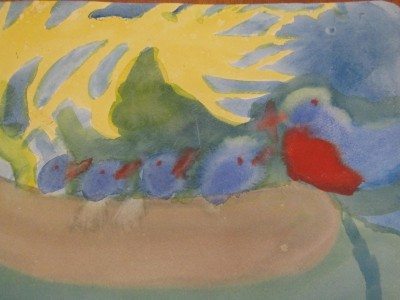Unique Aspects of Waldorf Education
Educating the Head, Heart, and Hands ~ the integration of thinking, feeling, and willing (activity) ~ is a hallmark of Waldorf education.
Waldorf education was founded by Rudolf Steiner in 1919 when he was asked to create a school for the children of factory workers in Stuttgart, Germany. World War I had just ended and the aim of the first Waldorf school was to contribute to economic and social renewal in a country devastated by war.
Steiner felt strongly that the school should provide a truly liberal arts education for all students. He structured the Waldorf curriculum to weave the lively arts into all subjects because he saw that they bring joy and help make the learning memorable.
Today, over 100 years later, the Waldorf school movement is growing as is the Waldorf homeschooling movement. This page offers descriptions of some of the more unique aspects of Waldorf education.

The Arts – Drama, painting, music, drawing, modeling, etc. are integrated into the academic curriculum, including mathematics and the sciences. Education through the arts awakens imagination and creative powers, bringing vitality and wholeness to learning. No other educational method gives such a central role to the arts as does Waldorf education. (If you want to read more on this, see The Seven Lively Arts. And check out our free guide for ideas on Weaving the Arts into Homeschooling.)
Practical Work – Practical work, like crafts and handwork, is part of the curriculum from kindergarten through high school. All children learn to knit in first grade and then crochet in second or third grade, creating colorful, utilitarian projects. Decades before brain research could confirm it, Rudolf Steiner recognized that brain function was founded on body function. Learning to knit and crochet in the early grades teaches motor skills which metamorphoses into lively thinking and enhance intellectual development later on. Coordination, patience, perseverance, and imagination are also developed through practical work. Activities like woodworking, house building, gardening, and shoe making, give children an understanding of how things come into being and a respect for the creations of others.
No Textbooks – Textbooks are not used in the elementary grades, and only very selectively in high school. Instead, the teacher creates a presentation out of his or her research and finds beautiful stories to deliver the content. Students make their own books for each subject, recording and illustrating the substance of their lessons. These main lesson books, often artistic and beautiful, are another important way in which art is integrated into every subject.
The “Main Lesson” – The morning main lesson is a one-and-a-half to two-hour period in which the main academic work of the day is presented. The selected subject is taught in a comprehensive three or four-week block, allowing for freshness, enthusiasm and a concentrated, in-depth experience that gives children time to digest what has been learned. In fact, Waldorf education was the first to recognize the value of “block” learning. Immersion in a single subject promotes horizontal integration of cognitive and artistic disciplines, as well as vertical integration through an ascending spiral of learning that revisits subjects throughout the year – and from year to year. This results in a profound, age-appropriate education.
The Teacher – In Waldorf education for the classroom, a teacher accompanies the same class of students for multiple years, teaching all the main academic subjects. This allows a teacher time to bond with the children, develop their potential, and ensure the kind of continuity and follow-through that will optimize each child’s educational experience. Sounds a lot like homeschooling! This approach happens naturally in a homeschool setting. Teaching is regarded as an art, and the curriculum is intended to be instructional as well as inspiring.
Humanities & Language Arts – An extraordinary education in the Humanities begins with mythology and legends, taking students through the full sweep of the world’s cultural heritage. A rich Oral Language environment – including songs, poems, and games – sets the stage in the earliest grades, replicating the natural historical course of human learning. Human beings first perceived their world, then pictured it and spoke about it. And out of those pictures and sounds, they further abstracted written signs and symbols. From stories to pictures, writing precedes reading. In all the grades, primary works from the world’s finest literature (Aesop’s Fables, the Bhagavad Gita, the Kalevala, etc.) are used for reading material. By living into these cultures through their legends and literature, children gain flexibility and an appreciation for the diversity of humankind.
The Sciences – Waldorf Education emphasizes experiential learning over direct cognitive instruction. For example, the teacher sets up an experiment and calls upon the children to observe and discuss their findings so that they can discover the underlying formula or law. As a result, independent thinking and sound judgment develop naturally. Science begins with lots of time outdoors and nature study which leads to keen observation of scientific experiments in the later grades.
Music – Music permeates and harmonizes life in Waldorf education through a curriculum designed to develop the innate musicality that every child is born with. Children sing and learn to play the recorder and possibly a lyre. By third or fourth grade, string instruments can be introduced. Music adds joy to the day and a humanizing influence in a child’s life, strengthening the will and capacities for the future.
Foreign Languages – Waldorf Education considers foreign languages and music to be integral parts of a curriculum. Languages are taught through the recitation of songs and verses through the immersion approach, giving the children insights into other cultures.
Eurythmy – Eurythmy is an artistic form of movement unique to Waldorf education. In prescribed exercises choreographed to music and poetry, eurythmy interweaves and harmonizes knowledge from academic subjects with artistic movement.
Want to see how these subjects are woven into main lesson blocks? Check out the Waldorf Block Rotation for Grades 1-8.



